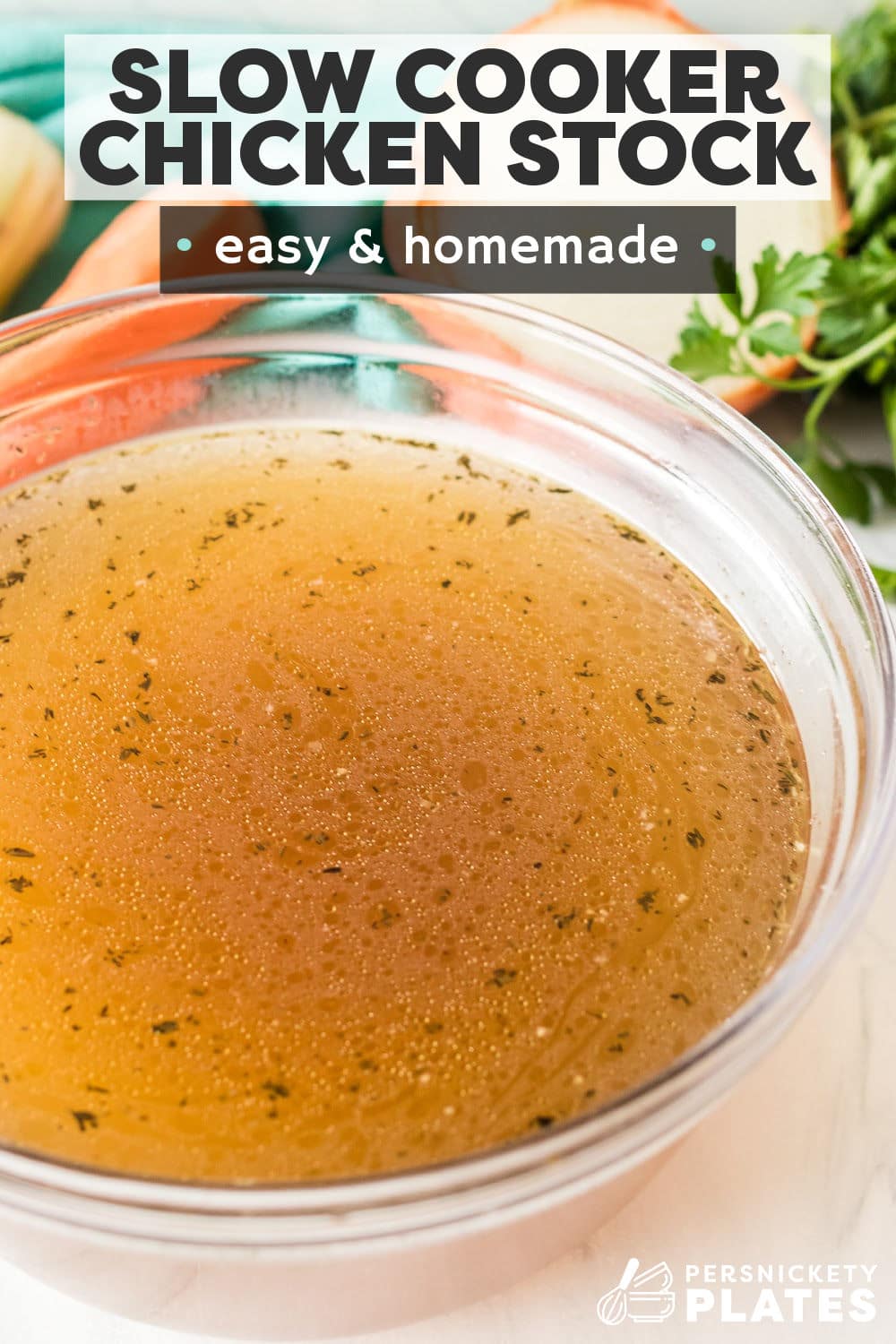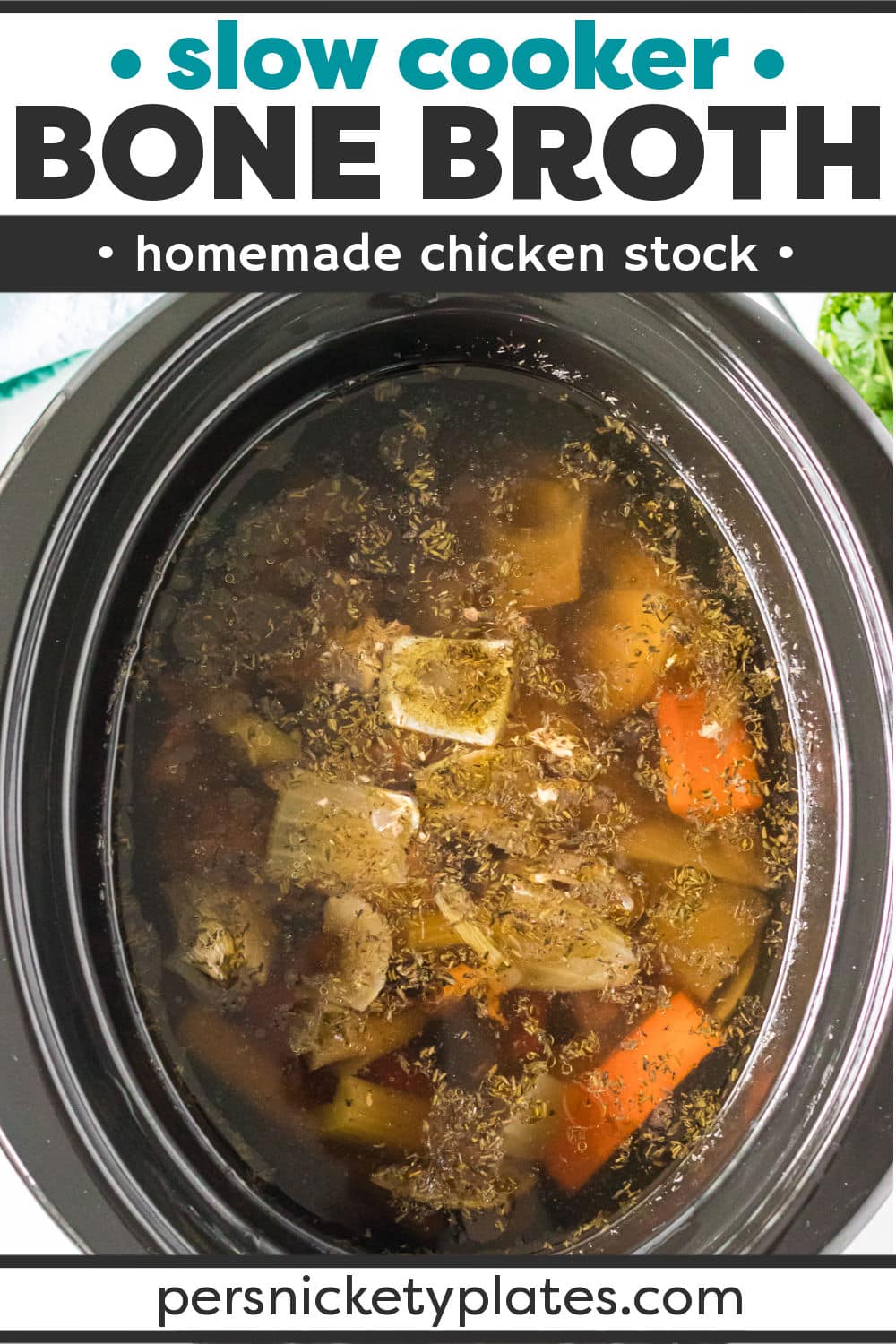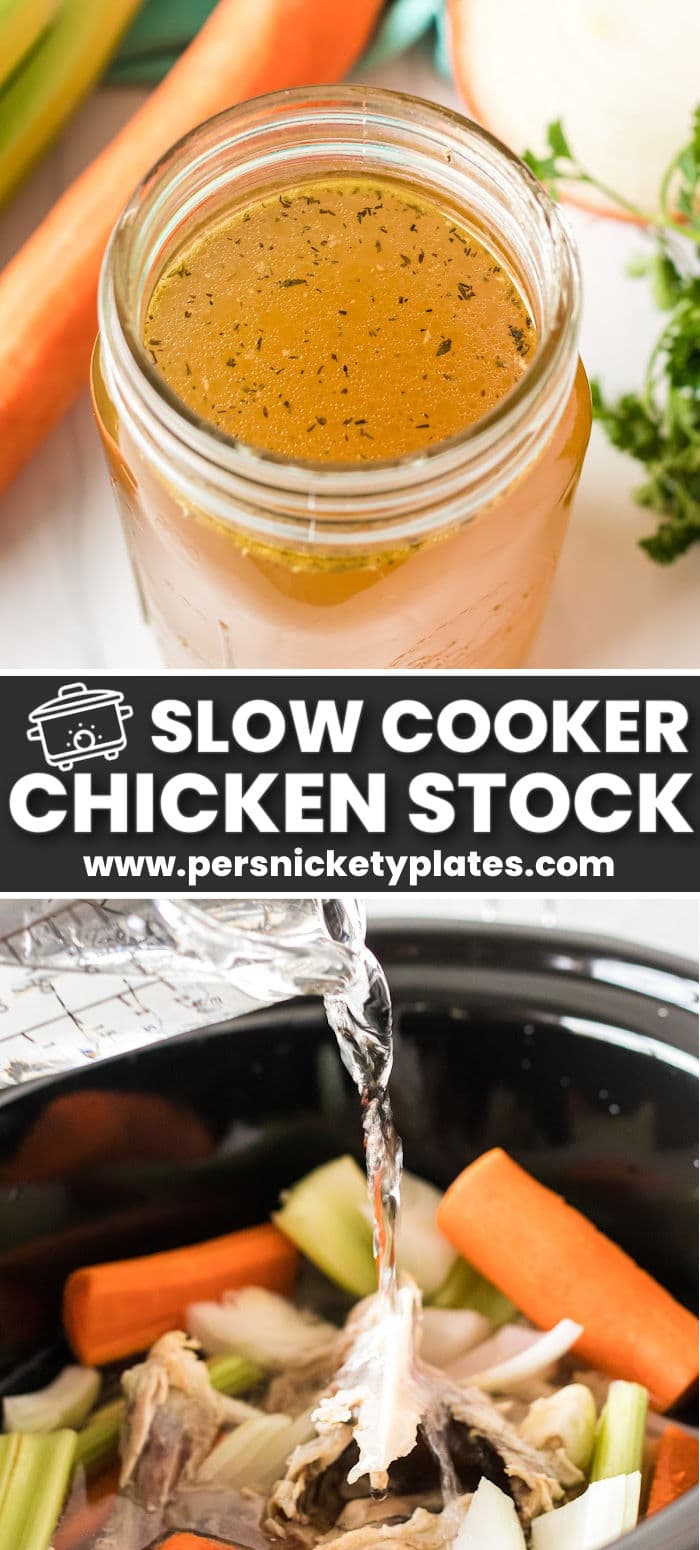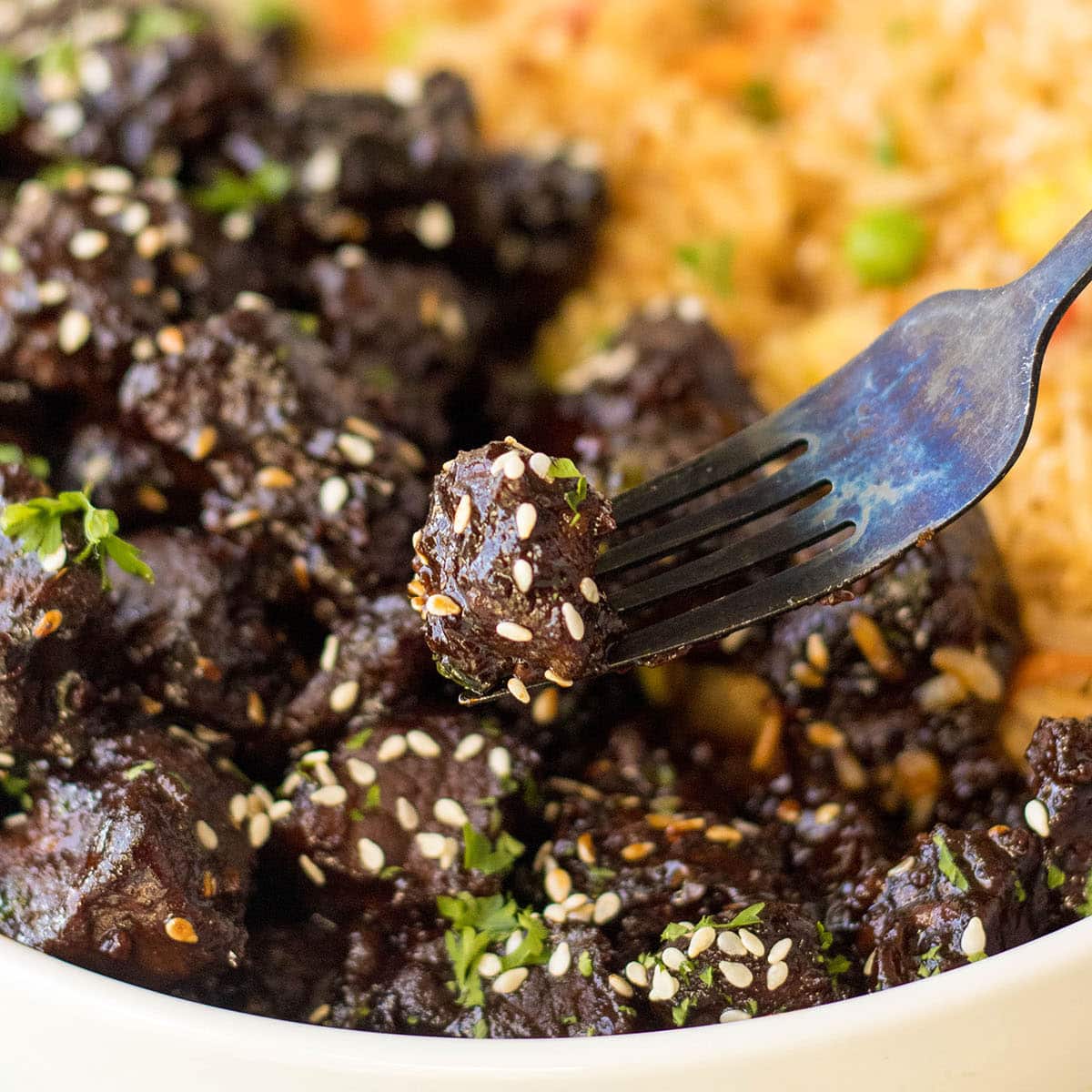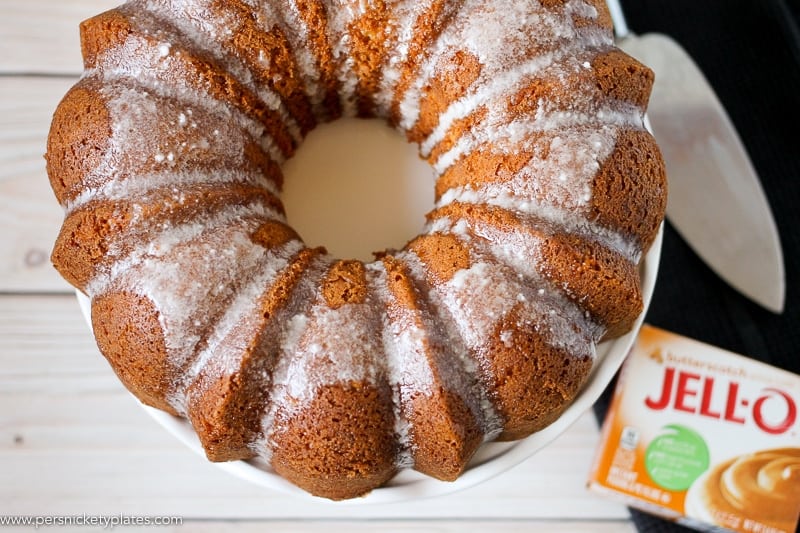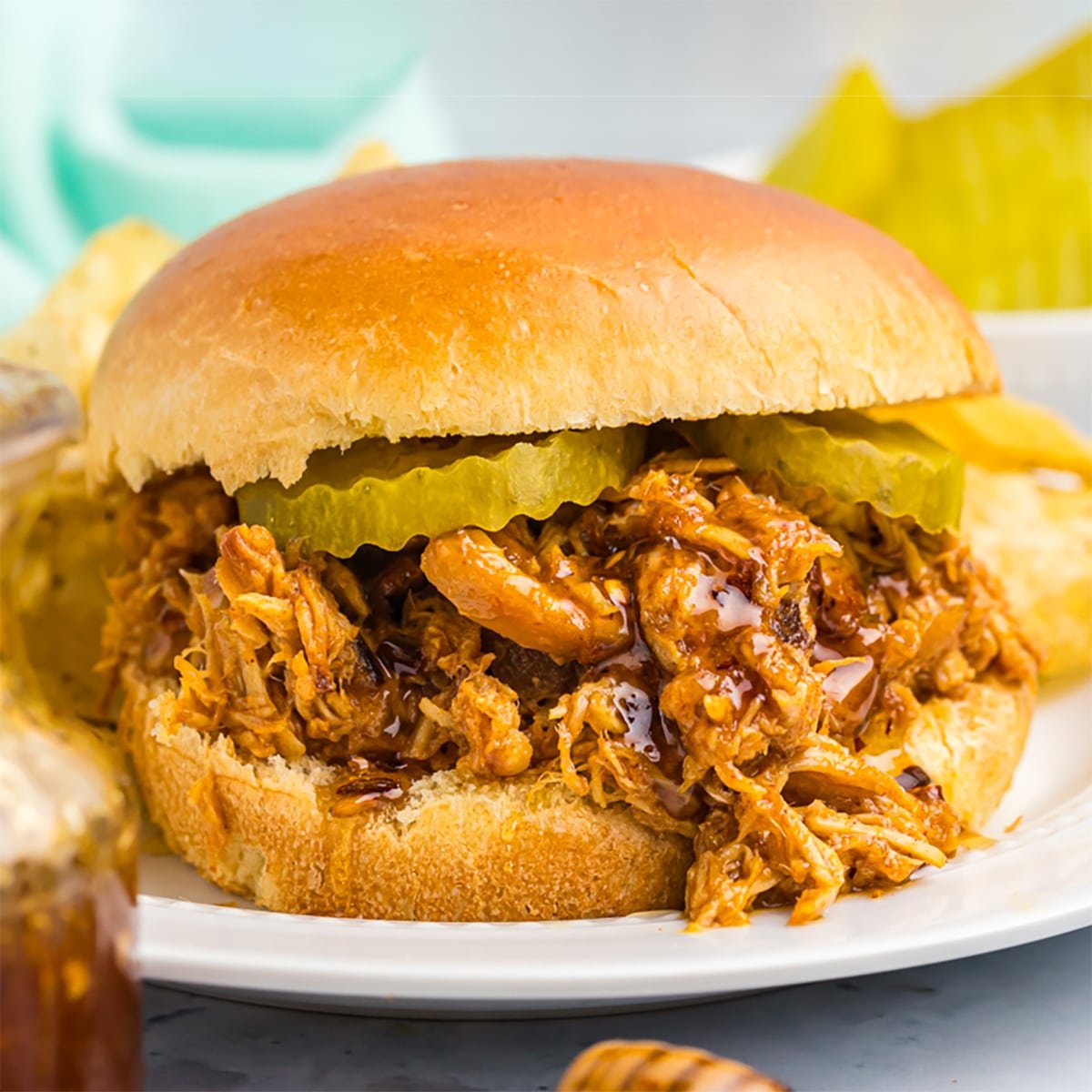This post may contain affiliate links meaning if you buy from them, I will make a few pennies, at no cost to you. See disclosure here.
Learning to make slow cooker chicken stock is one of the best and easiest ways to make a nutrient-rich stock that can be used for soups, gravies, sauces, and more. This simple, budget-friendly, dump-and-set recipe delivers a rich broth that is so flavorful you’ll find it hard to go back to using a store-bought can or carton!
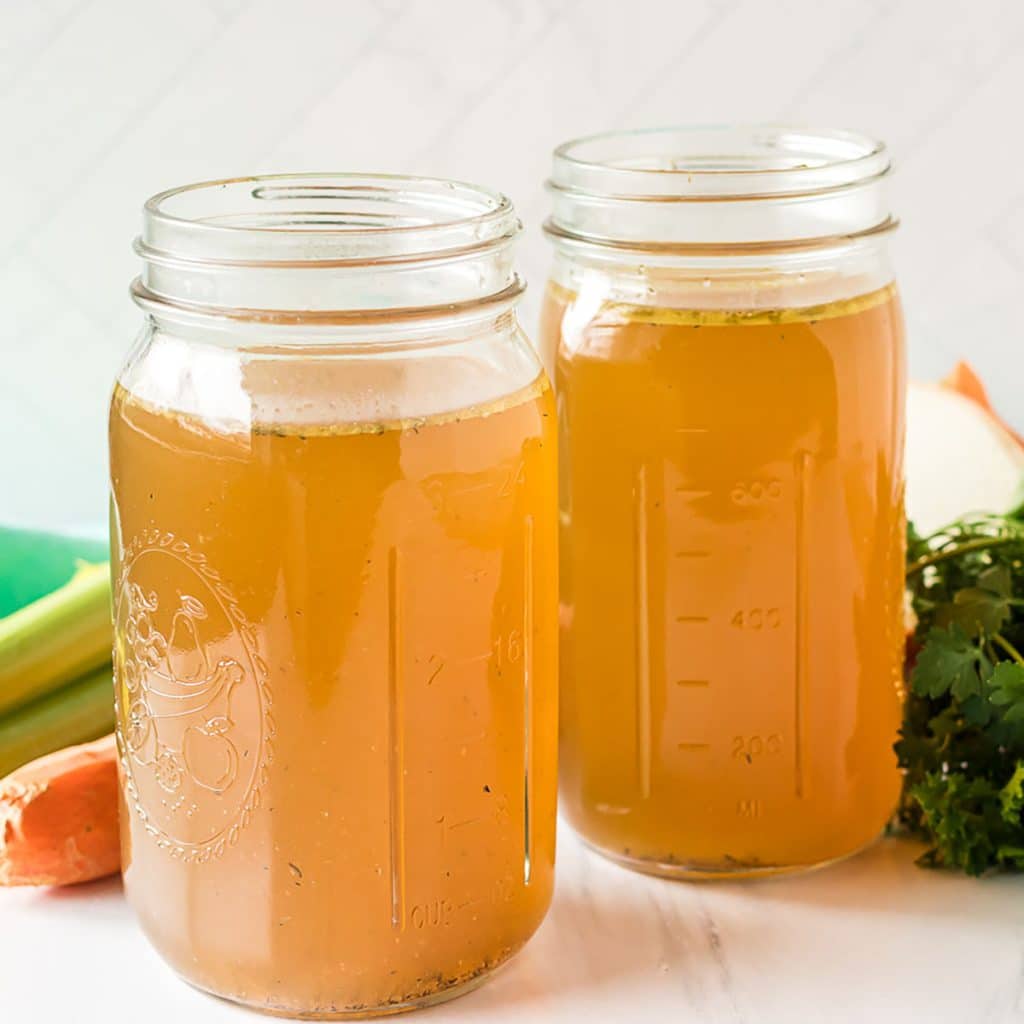
Crockpot Chicken Stock
Homemade stock is something I always have on hand for recipes like leftover slow cooker turkey noodle soup, easy chicken noodle soup, and slow cooker chicken gnocchi soup, especially during cold and flu season!
Sometimes I’ll replace water with stock when I make stovetop rice for extra flavor. Then, I’ll save the rest for when I make Risotto!
It’s easy, effortless, and cost-effective. All it takes is to dump leftover chicken bones, either from the carcass of a whole chicken or just the pieces into the pot along with veggies, seasoning, and water.
Let the crock pot do its thing for 12 hours and allow the flavors to marry and all the nutrients to be released for a healthy and delicious stock ready to be used immediately or kept frozen for months later.
Stock vs. Broth vs. Bone Broth
You, me, and the rest of the home cooks around the world seem to be a bit confused as to the difference between all three. Rightly so, they’re so similar in the way they are made and the way they are used!
The major difference between stock and broth is stock uses more bones than it does meat and broth uses all meat. Stock is simmered for longer, has a more robust flavor, and doesn’t tend to have too much seasoning.
The broth is lighter, isn’t simmered as long so it’s relatively quick to make and can include meat and maybe some bones, and is generally well seasoned.
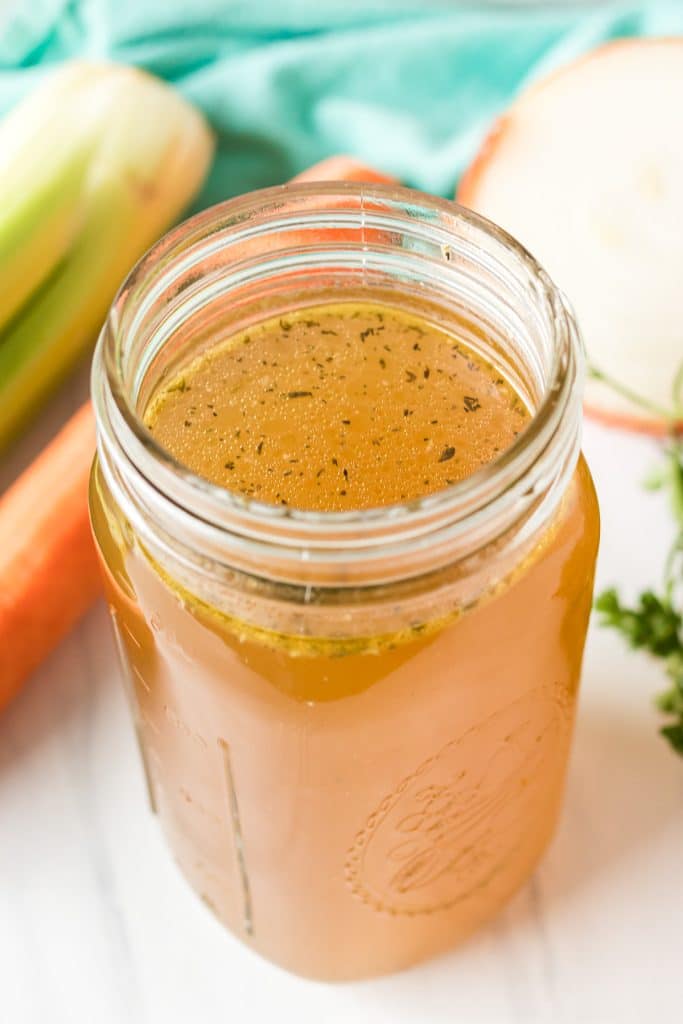
So, what is Bone Broth?
When we’re talking about bone broth this is made the same way stock is made except it’s simmered for much longer, sometimes up to 24 hours. What this does is extracts the collagen from the bones which is why there is usually gelatin formed at the top which has a gravy-like consistency.
All three can be used to flavor soups, stews, and sauces, but it’s typically broth or bone broth that is sipped and enjoyed on its own as a hot drink.
Why you’ll love Slow Cooker Chicken Stock
Good to keep on hand – If you are a big fan of making homemade soups, stews, chilis, sauces, casseroles, and tons of immune-boosting recipes, you’ll never run out of reasons to keep a jar of homemade chicken broth on hand.
Better than store-bought – When we make it ourselves we get to control the flavor, what we put in it, and the amount of sodium that gets added.
Makes a lot – A crockpot full of chicken stock never goes to waste. I store what I know I’ll use in the fridge and I’ll freeze the rest in souper cubes or freezer-safe containers.
Budget-friendly – It uses just a few simple ingredients and most of it can be scraps. A great way to avoid waste is to collect leftover bones and veggie scraps (I’m talking onion peels, broccoli stems, carrot peels, and ends of veggies) in freezer bags. Add to it every time you have scraps then add them to the pot for so much flavor. Plus, store-bought broths are around $4 per carton!
Equipment you’ll need
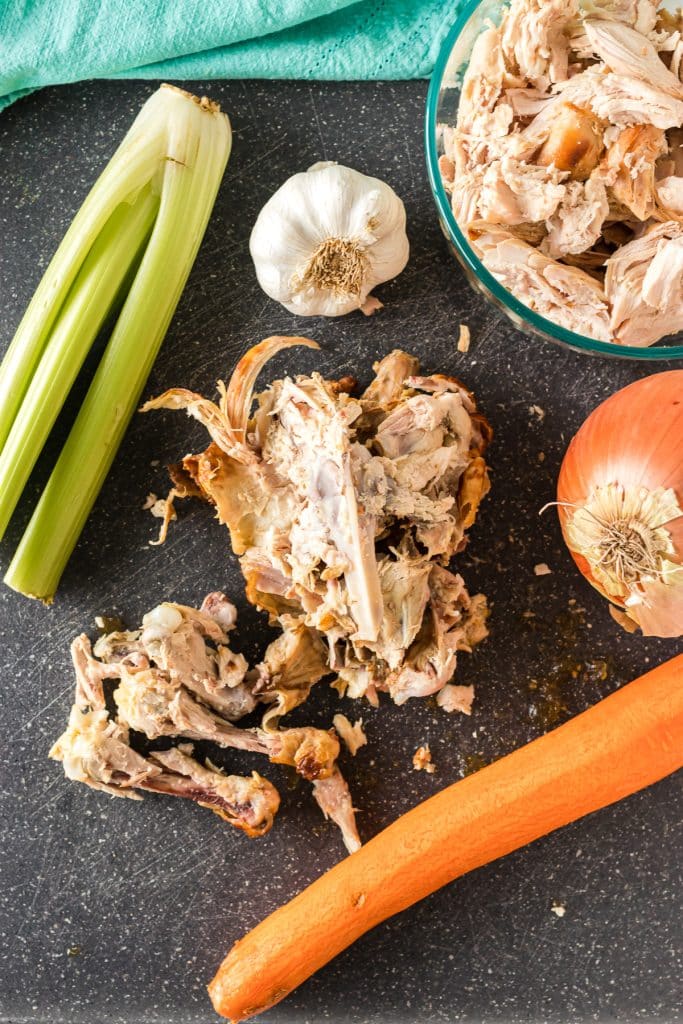
Ingredients
Below is a list of the ingredients you’ll need to gather to make this easy recipe. Scroll all the way down for the full recipe card.
- Chicken Bones: The more bones the better! You’ll need about a pound and they can be from a carcass, raw bones, scraps from a rotisserie chicken, whatever. Something to keep in mind is that the higher quality the chicken (organic, free run, grain fed) the higher the nutrients provided.
- Vegetables: Chunks of celery and carrots. No need to be fancy, just roughly chopped is fine. They are for flavor and will be discarded afterward. My favorite way to make this is to save vegetable scraps from the week and then at the end of the week, whip up a batch of stock.
- Aromatics: Onion and garlic are super high in antioxidants and are always great for adding depth of flavor.
- Water: The liquid used to turn the ingredients into a chicken stock. It gets infused with all of the other ingredients making it healthy and tasty.
- Seasoning: Dried thyme, salt, pepper and a single bay leaf. Don’t be afraid to season your broth, it needs it!
How to make Chicken Stock in the Slow Cooker
- Step One: Add all the bones to the basin of a 6-quart slow cooker, then scatter the veggies and aromatics all around the chicken.
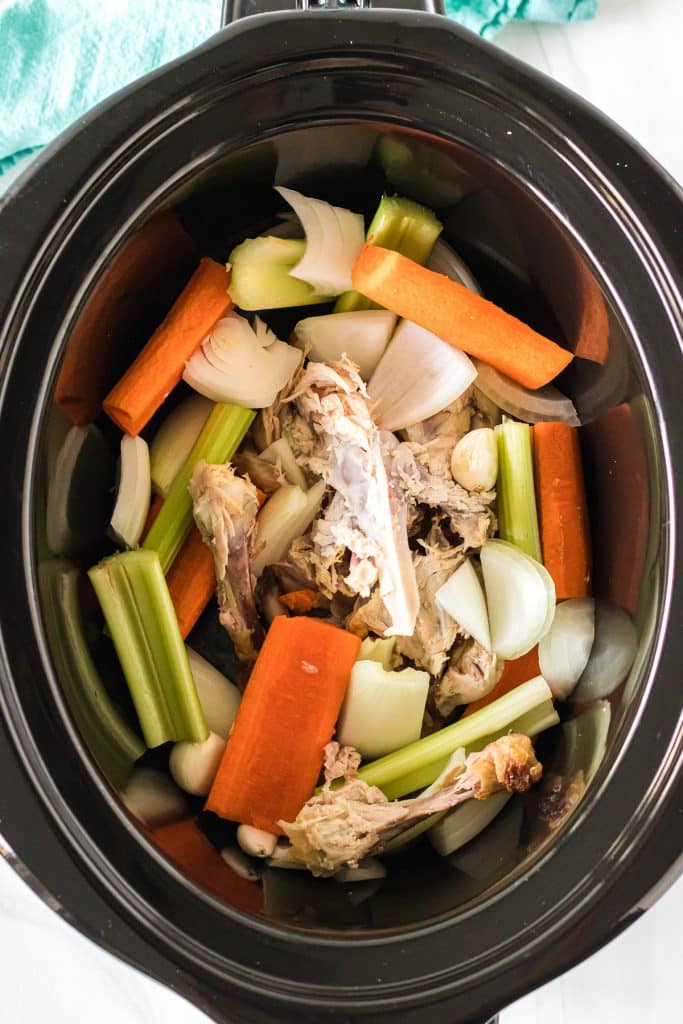
- Step Two: Pour in the water and add the seasonings. Pour in the water and add the seasonings. You want enough water to cover the bones and veggies. Cover with the lid.
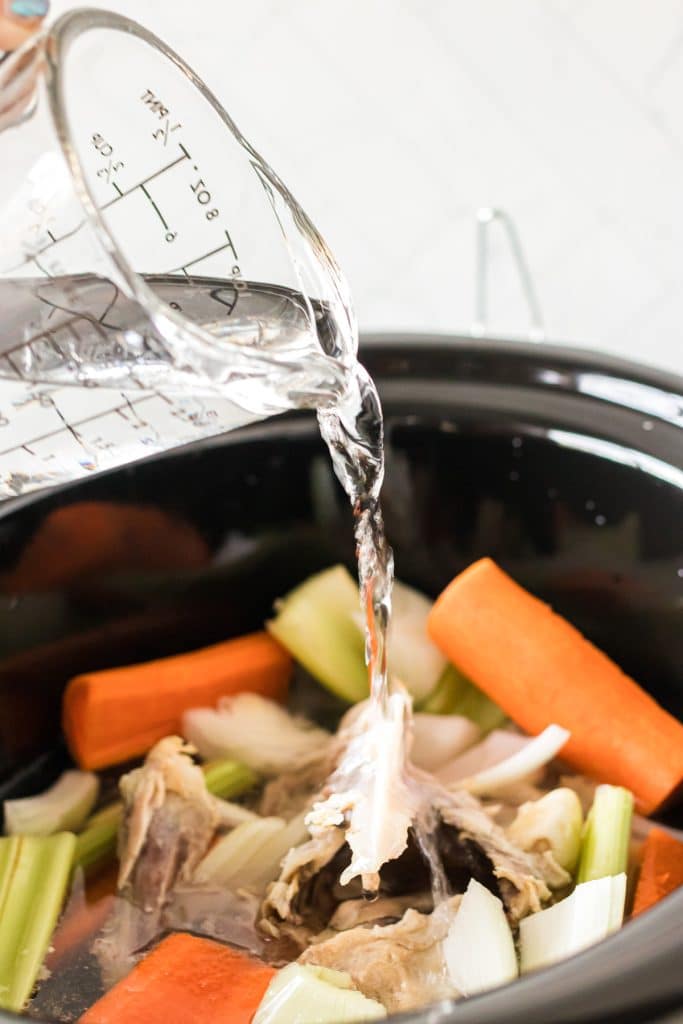
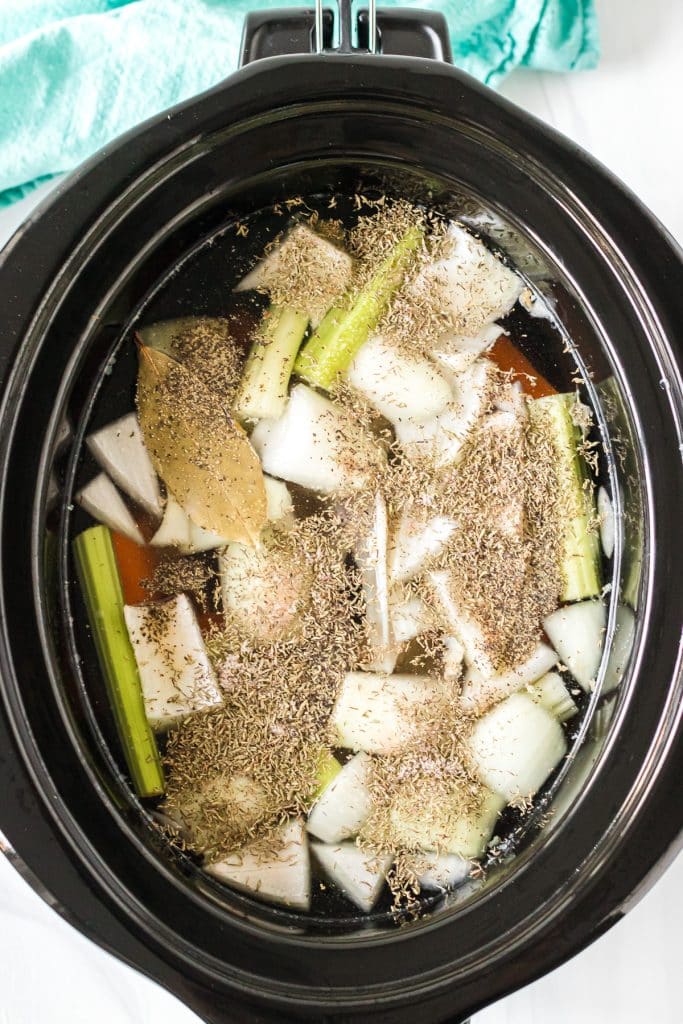
- Step Three: Cook on LOW for 12 hours and up to 24 hours. If you leave it for 24 hours, you’re in slow cooker chicken BONE broth territory.
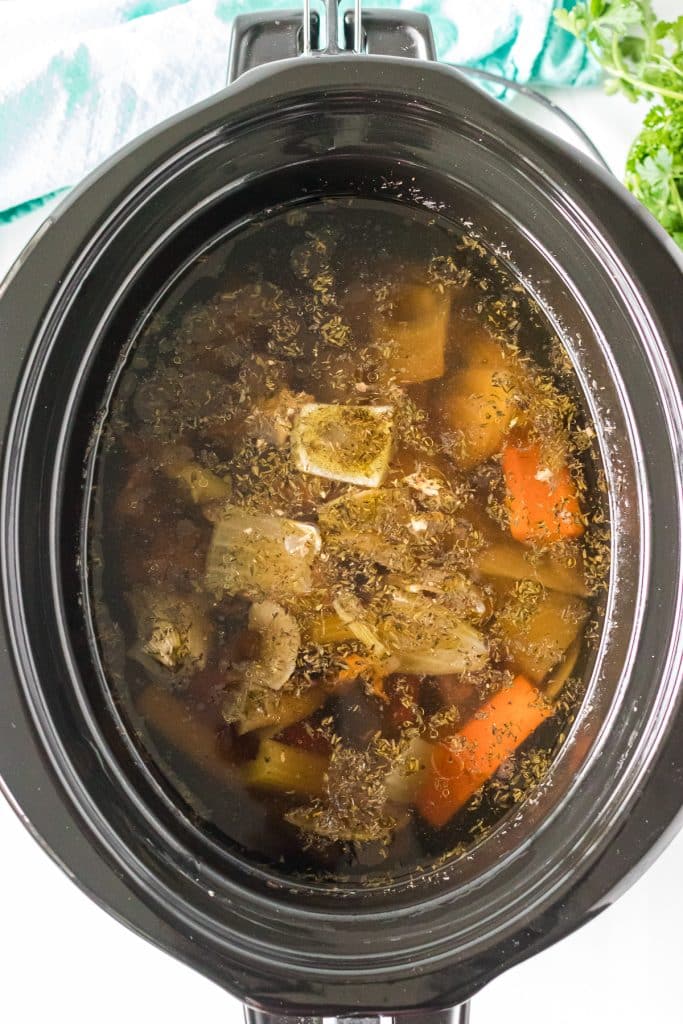
- Step Four: Once the cooking time is up, strain the broth into a large bowl and then transfer it to glass jars or freezer-safe containers.
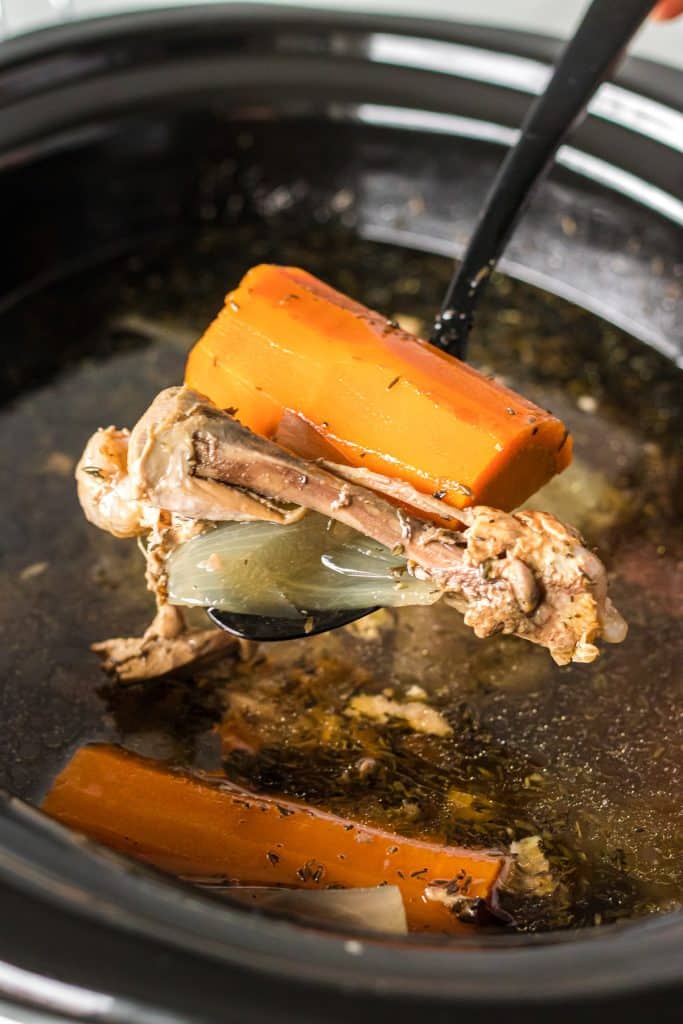
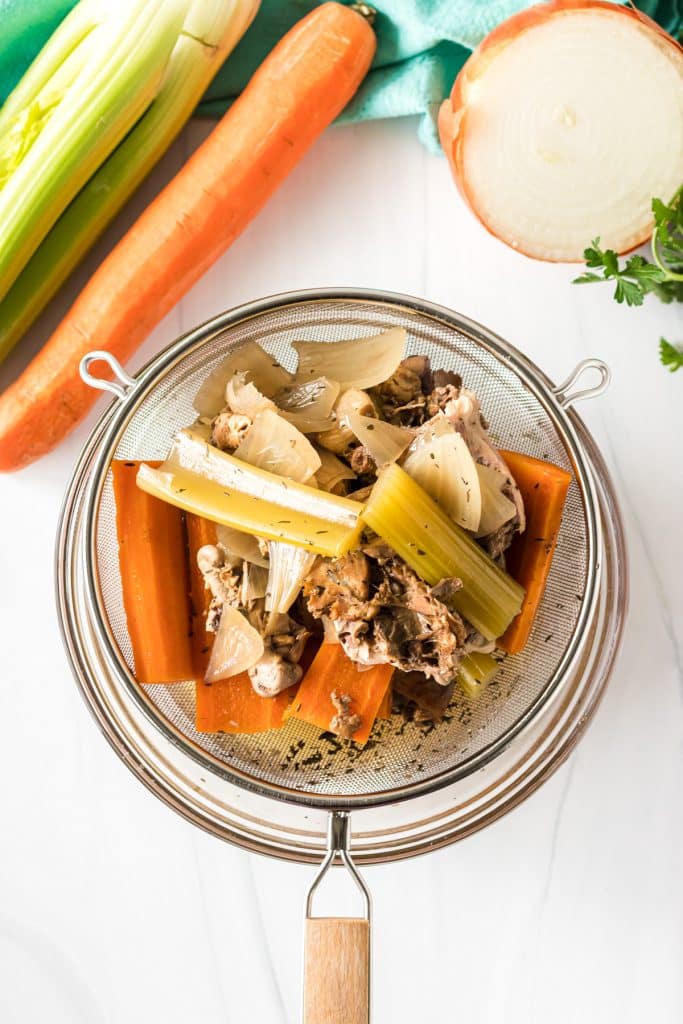
- Step Five: Allow them to cool completely before placing lids on them. Store in the fridge or freezer.
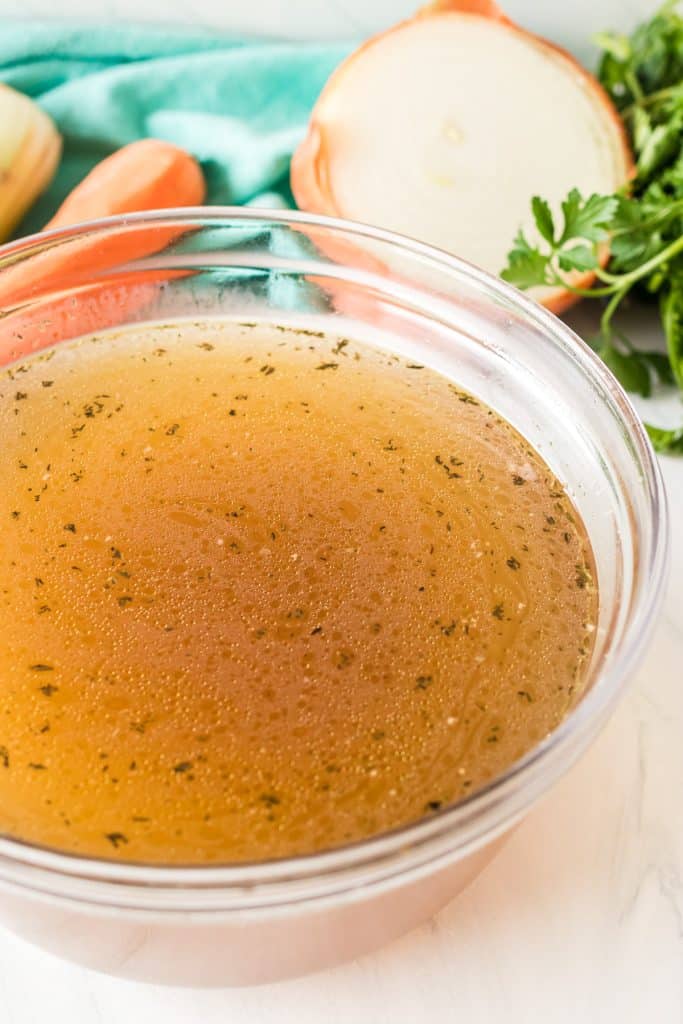
Ways to use Slow Cooker Chicken Stock
Adding a rich homemade chicken stock to any recipe is a great way to replace what would normally be store-bought stock or broth. We know it’s much healthier but also better tasting!
This slow cooker chicken stock is a great recipe for making soups like one pot chicken and dumplings and homemade cream of chicken substitute, stews, chili, rice, quinoa, casseroles, risotto, and more!
Sauces and curries like slow cooker butter chicken, as well as casseroles like this green bean casserole all require a chicken stock.
So, make a big batch from scratch and save yourself a trip to the grocery store!
Possible Substitutions/Additions
- Clean out your fridge and add any extra veggies you want to your stock. It can only enhance the nutrition and increase the flavor.
- Added seasoning could include peppercorns, red pepper flakes (for a spicier stock), fresh herbs like parsley and dill, or extra dried herbs like oregano, tarragon, and rosemary.
- If you’re making a bone broth in the end, add a bit of apple cider vinegar to help extract the nutrients from the bones.
- You can use this recipe to make a broth instead if preferred. Use more leftover meat than bones and follow the remaining instructions as directed.
- Swap the chicken bones for turkey bones, beef bones, or fish bones and make a completely different kind of stock!
- Omit all the bones and meat and ramp up the veggies to make a delicious vegetable stock.
How to reheat and store Slow Cooker Chicken Stock
How to store leftovers
Let the stock cool completely then transfer it to mason jars with tight-fitting lids or your airtight container of choice.
How long will it last in the fridge?
Keep it refrigerated for up to 4 days.
Can I freeze it?
Absolutely! I love using souper cubes to portion out my stock. That way I don’t have to thaw it all and use an entire jar or container full, especially if I only need to use a bit. Souper cubes come in a variety of shapes and sizes for things like freezing cookie dough, jams, meatloaf, and other make-ahead freezer meals.
This way I can release just one section of the souper cube container and use it without having to thaw the rest.
When the kids were really little I would freeze the homemade chicken stock in ice cube trays and use a bit of it to puree food.
How to reheat crockpot chicken stock
If you’re reheating a lot, I’d say the stove top is the easiest way, in a pot over medium-low heat. You can also use the microwave to heat your stock.
Alternatively, if you’re using it in a recipe, you don’t need to heat it at all, just add it as is.
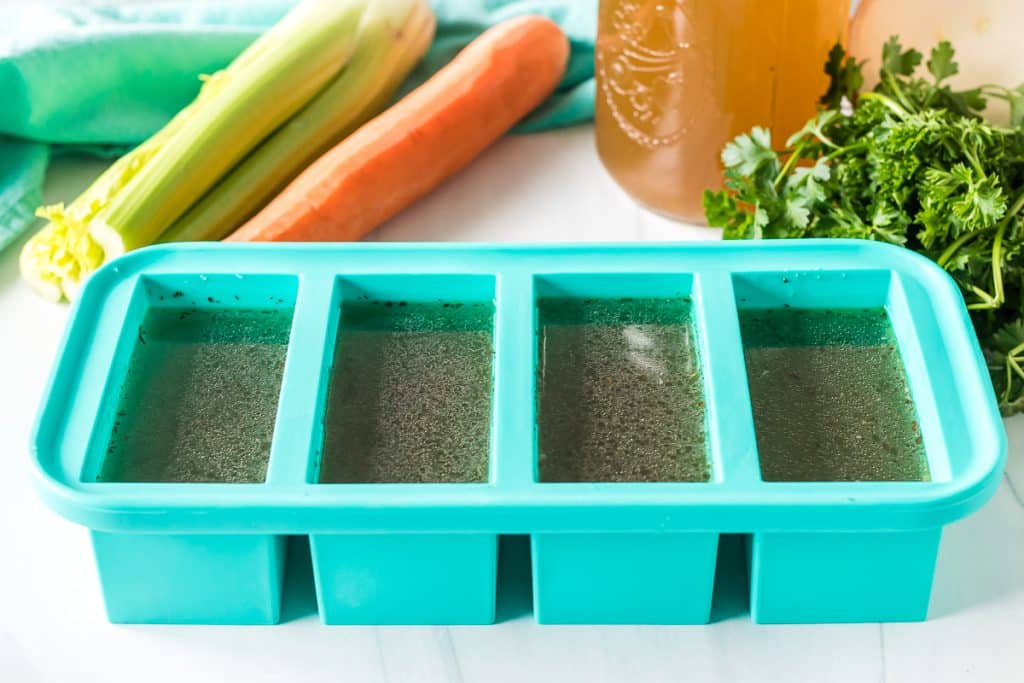
FAQs
Can I use frozen chicken carcass?
Certainly. If you keep leftover chicken bones frozen for this very reason, toss them in as is. No need to thaw them.
Are there any vegetables I shouldn’t add to my slow cooker chicken stock?
I’d say any cruciferous veggies like broccoli, cauliflower, or Brussels sprouts are ones to avoid. For no other reason than they may result in a bitter flavor.
Should I skim the top of the pot?
If you see a layer of fat developing at the top of the liquid, skim it off as best as you can. If you don’t, it will separate once it’s cooled and be much easier to remove. This will help eliminate any unwanted fat and preserve the flavors without diluting them with extra oil.
Need more from scratch recipes? Try these:
Click here for my entire collection of sauces and seasoning recipes.
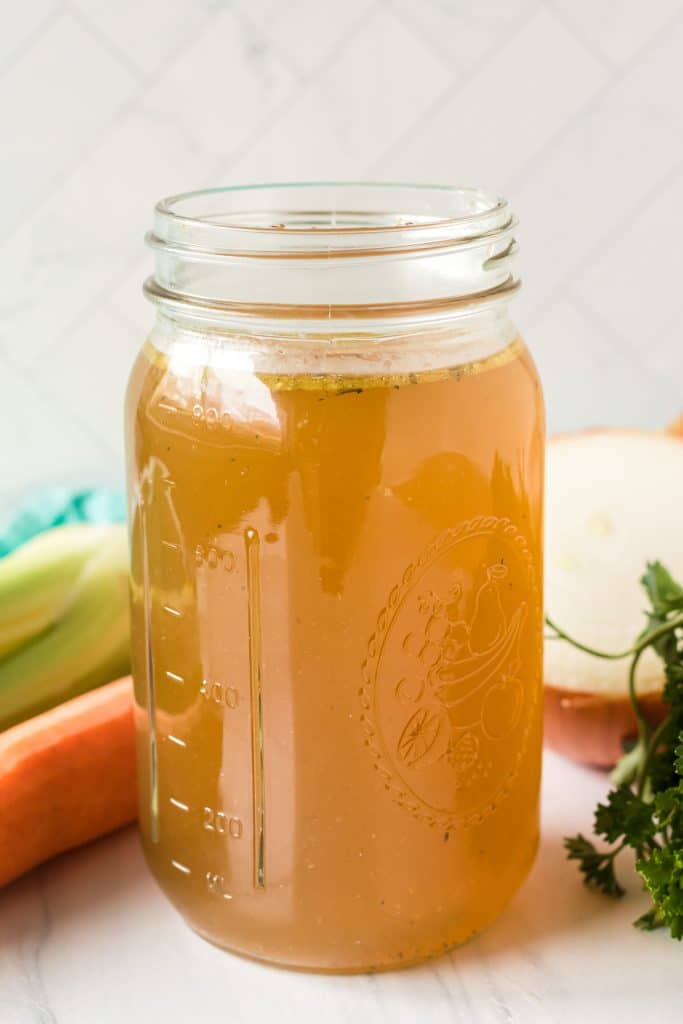
Did You Make This?
If you made this recipe, I’d love to know how it went in the comments section below.
You can also tag me on Instagram – @melissa_pplates or share a pic in the Persnickety Plates Community Facebook group. I love seeing what you’ve tried!
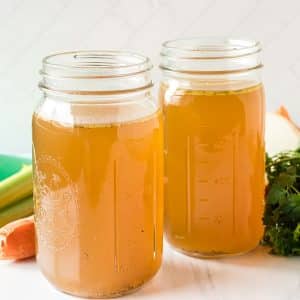
Slow Cooker Chicken Stock
Equipment
Ingredients
- chicken bones approximately a pound
- 4 stalks celery cut into chunks
- 1 large carrot cut into chunks
- 1 large white onion quartered
- 4 cloves garlic
- 8 cups water
- 1 tablespoon dried thyme
- ½ tablespoon salt
- ½ tablespoon black pepper
- 1 large bay leaf
Instructions
- To the basin of a 6 quart slow cooker, add the chicken carcass and bones.
- Scatter the chopped celery, carrot, onion, and garlic cloves around the chicken.
- Pour in the water and add the thyme, salt & pepper, and bay leaf.
- Cover and cook on LOW for 12 hours.
- Once the 12 hours are up, place a strainer over a large bowl and use tongs to remove the large vegetables and bones to the strainer. Then, pour the broth over the strainer.
- Transfer the stock to mason jars or freezer containers to let cool. Once cool, cover and store in the fridge for up to 4 days, or freeze for up to 3 months.
Notes
Nutrition
Nutritional information is an estimate and provided to you as a courtesy. You should calculate the nutritional information with the actual ingredients used in your recipe using your preferred nutrition calculator.
